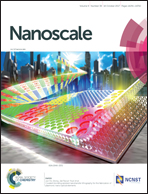Tailored release of triiodothyronine and retinoic acid from a spatio-temporally fabricated nanofiber composite instigating neuronal differentiation†
Abstract
Regeneration of the central and peripheral nervous system is challenging since the functional restoration of injured nerves is an incredible task. The fabrication of an ideal nerve guide that fulfills the requirement to regenerate nerve tissue is a herculean challenge requiring a combination of both biochemical and topographical cues. The present study explores the combinatorial effect of aligned nanofibers and the regulated delivery of triiodothyronine and retinoic acid on nerve regeneration. A sequential release mechanism is adopted in fabricating the nanofiber scaffold, with triiodothyronine incorporated into the nanofiber shell ensuring its prior release, followed by retinoic acid (entrapped within zein nanoparticles) from the core. The composite nanofibers thus fabricated possess excellent mechanical, physical and thermal properties and good topographical morphology and were highly biocompatible. The nanofibers were scrutinized for their efficacy in stimulating differentiation to a neuronal phenotype. The elongation factor (E-factor) of the neural cells had doubled in the bioactive incorporated composite compared to other scaffolds, as observed on phalloidin staining of their cytoskeleton, which endorsed enhanced neural differentiation on the fabricated nanofiber scaffold. There was a significant increase in the expression of neural-lineage specific markers on investigation of mRNA by real time PCR, showing a 10 fold increase in the gene expression of β-III-tubulin, a 5.5 fold increase for microtubule associated protein 2 gene and 3.5 fold for neurofilament M gene in the cells cultured over bioactive incorporated aligned nanofiber composites. Similarly protein expression was analyzed by immunofluorescence and flow cytometry studies, which showed an increase in the expression of β-III-tubulin in the composite nanofiber. This corroborates that neuronal differentiation is enhanced by the aligned nanotopography and spatio-temporal delivery of triiodothyronine and retinoic acid, opening avenues for nerve regenerative graft fabrication.



 Please wait while we load your content...
Please wait while we load your content...